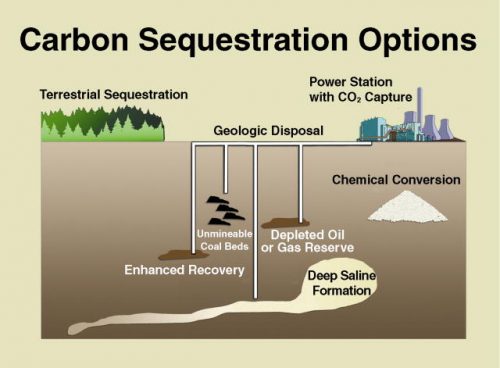INTRODUCTION CARBON SEQUESTRATION:
Carbon sequestration refers to capture or long term storage of carbon dioxide either from the source of emission or any other methods which may include some natural processes that can remove or decrease the amount of carbon die oxide currently available in the atmosphere. Carbon can be sequestered or captured from the atmosphere by means of natural or artificial processes.

The purpose of carbon storage is to deposit it again into the reservoir.
NEED FOR CARBON SEQUESTRATION:
As a result of latest technologies and overpopulation the utilization as well as emission of carbon dioxide has been increased dramatically. The impacts can be observed in the form of GLOBAL WARMING and OZONE LAYER DEPLETION. Our global surface temperature has been increased up to 0.8 degree Celsius during the last 19th century and 11 out of 12 warmest years on record have been occurred. Moreover the sea level has been increased 15 to 23 cm as the ice is melting from the glaciers due to increase in temperature.
Ecosystem is greatly disturbed as the amount of green house gases increased in the atmosphere due to different anthropogenic activities like burning of biomass, fossil fuels and soil cultivation which is one of the main factor that is responsible for Global warming and Climate Change. The concentration of green house gases has been increased due to an important factor that is rapid increase in human population especially after the industrial revolution around 1850. The concentration of CO2 has increased by 31% from 280 ppmv in 1850 to 380 ppmv in 2005, and is presently increasing at 1.7 ppmv yr−1 or 0.46% yr−1. Concentrations of methane (CH4) and nitrous oxide (N2O) have also increased steadily over the same period.
So, there is a strong need regarding the above mentioned factors to stabilize the abundant amount of carbon dioxide and other green house gases in order to mitigate the risks of global warming. There are general 3 strategies by which we can reduce the emission of carbon dioxide:
1. reducing the global energy usage.
2. Developing low carbon containing fuel.
3. Sequestering carbon from its emission sources or either from atmosphere using natural
or engineering techniques.
METHODS OF CARBON SEQUESTRATION:
Sequestration methods includes:
1. Soil sequestration (enhancing the amount of carbon storage in soil).
2. Plant sequestration (enhancing the amount of carbon storage in forests and other
vegetations).
3. Geosequestration (increase the carbon storage in underground geological formations).
4. Ocean sequestration (storing the carbon in oceans).
5. Mineral Carbonation (undergo different carbon reactions to form inorganic carbonates).
SOIL SEQUESTRATION:
Soil contains about 700 gigatonnes to 3000 ggt of carbon which is about three times more than carbon stored in the atmosphere. Agriculture soil contains 50 -70% of organic carbon that is naturally present before cultivation. Due to increase in the population more agriculturable land was required and the forests were converted into cultivatable land as a result amount of carbon decreased. Organic carbon present in the soil was decomposed due to disturbances and low carbon enter the ground as biomass was reduced , agriculture also required tillage ,harvesting and grazing which dramatically decreases soil carbon content.
Different strategies are required to make the soil more efficient that it could absorb the amount of carbon as much a possible so that its fertility would be increased. By applying proper management practices we can retain or either increases the carbon in the soil that includes low tillage or no tillage, use of manures, conversion of monoculture systems to diverse systems, crop rotations, winter cover crops and by establishment of vegetation on steep slopes. These practices might affect the amount available carbon in the soil or increase carbon turnover (> 5) years.
Carbon is released into the atmosphere as carbon dioxide due to decomposition by microbial activity. The storage of carbon through such methods is limited because the type of soil may interfere in prospective of its carbon holding capacity and climate which determines the rate of decomposition. Increase in temperature and soil moisture increases microbial activity and increase in average temperature can favor in enhancing the turnover of liable carbon.
According to recent research “Biochar”can be used it is a charcoal which is form by heating organic materials such as crop residue, wood chips, municipal waste or manure in oxygen limited environment (pyrolysis). This can occur in a facility that harnesses the resultant ‘bioenergy’ to produce electricity, and the biochar residue can be returned to the soil. As a more generally applicable process, biochar can also be produced through replacement of conventional slash and burn practices with ‘slash and char’, where complete burning is inhibited, for example by dampening the fire with earth. Biochar is chemically very stable and the carbon can remain in the soil for hundreds to thousands of years.
PLANT SEQUESTRATION:
Plants need sunlight along with atmospheric carbon dioxide to prepare glucose via process of photosynthesis in meanwhile the convert the atmospheric carbon dioxide into carbohydrates so they can be said as natural sink for carbon. With increase in the amount of atmospheric carbon due to the high burning of fossils fuels rate of photosynthesis has been increased however, plant has certain capability to sequester carbon as plant develops into a fully mature one it slows down photosynthesis. We can enhance the amount of carbon uptake from the atmosphere by planting vegetation and forestry practices.
GEOSEQUESTRATION:
Geosequestration refers to store carbon and other green house gases underground, away from atmospheric contact. The most appropriate sites are deep geological formations, such as depleted oil and natural gas field sites or, natural reservoirs filled with saline water.
Geosequestration consists of three components scheme of carbon capture and storage (CCS), which are as follows:
• Capture of CO2 either before or after combustion of the fuel
• Transport of the captured CO2 to the site of storage, and
• Injection and storage of the CO2.
This scheme is very useful as it can reduce emission of greenhouse gases due to fossil fuel nearly up to zero.
OCEAN SEQUESTRATION:
Ocean is the largest source of storing carbon on the earth. Upper layer of the ocean can absorb huge quantity of carbon which is causing ocean acidification that is highly damaging for marine life. There are numerous methods to enhance the absorbing capacity of oceans few are discussed below:
IRON FERTILIZATION:
Iron fertilization is a technique used to encourage growth of phytoplankton’s which can absorb carbon more efficiently however this technique is very much controversial regarding its effects on marine ecosystem. Sperm whales increase the primary production and accelerate the deep transport of carbon into the oceans by depositing iron feces in the surface water of southern ocean. Iron rich feces causes rapid growth of phytoplankton’s and thus more atmospheric carbon is sequestered.
UREA FERTILIZATION:
Lan jones proposed that if we fertilize ocean with urea like nitrogen rich compound then this would enhance the growth of phytoplankton’s which in turn increases carbon storage in oceans. Australian company Ocean Nourishment Corporation (ONC) plans to sink hundreds of tons of urea into the ocean to boost CO2-absorbing phytoplankton growth as a way to combat climate change. In 2007, Sydney-based ONC completed an experiment involving 1 ton of nitrogen in the Sulu Sea off the Philippines.
MIXING LAYERS:
Mixing various layers of oceans results in transport of different nutrients in order to produce algal blooms whose results are somewhat similar to iron fertilization.
MINERAL SEQUESTRATION:
Mineral sequestration (also known as mineral carbonation) involves reaction of CO2 with metal oxides that are usually present in naturally occurring silicate rocks. The process resembles natural weathering phenomena, and results in the formation of natural carbonate products that are stable on a geological time scale. There are sufficient reserves of magnesium and calcium silicate deposits to fix the CO2 that could be produced from all fossil fuel resources. Although the weathering of CO2 into carbonates does not require energy, moreover the natural reaction is slow; therefore as a storage option the process must be greatly accelerated through energy-intensive preparation of the reactants. This technology is still in the development stage and is not yet ready for implementation; however, studies indicate that a power plant that captures CO2 and employs mineral carbonation would need 60–180 percent more energy than an equivalent power plant without the capture and conversion process. These reactions are as follows: CaO + CO2 → CaCO3
MgO + CO2 → MgCO3
Mg2SiO4 + 2 CO 2 = 2 MgCO3 +SiO2
LATEST RESEARCH AND DEVELOPMENT:
NEW DEVICE VACUUM AWAY CARBON DIOXIDE:
A new device has been placed in Iceland that is very efficient in absorbing carbon dioxide that it can suck up the carbon dioxide emitting from vehicles as far from Tokyo, proving itself a useful tool in fight against the ever rising levels of this particular green house gas. Carbon dioxide entraps the heat emitted by earth surface and sends it back to earth causing increase in temperature. This type of situation is alarming for scientist that they predict drastic climate changes. For the reduction of increasing levels scientists have devised ways like using energy sources which may include solar, wind power and alternative fuels like ethanol, natural gas and some kind of scrubbers that can be implemented on power plants to reduce carbon dioxide from exhaust.
Unlike these alternatives which reduce the carbon dioxide emission the new device is very much efficient it absorbs the carbon molecules already present in atmosphere or those which are being emitted by chimneys and convert it into pure carbon dioxide stream so it can easily be sequestered or used for oil recovery purposes.
“We are trapping carbon dioxide about 1,000 times faster than a tree does,” said study leader Klaus Lackner of Columbia University.
This device has an opening through which carbon dioxide enters and sticks to the absorbents inside the device. It has several advantages like this device could be placed near sequestration sites despite of emission areas. In contrast to scrubbers which can’t be applied to cars that contribute 20% global carbon dioxide emissions this device is applicable. Lackner has tested this device in Arizona and with some improvements it would be commercially available within few years. We will see future with less risk of climate change.
KYOTO PROTOCOL:
Kyoto protocol is a way to finance CSS projects through its clean development mechanism. At COP17 in Durban final agreement was signed according to which CCS programs were able to seek support.
CONCLUSION:
In the world of modern technology more fossil fuel is required to burnt in order to meet increasing demands of population. Industrialization and vehicles have dramatically higher the rates of carbon dioxide emission leading to threats like global warming and climate change which can bring diseases like cancers and eye diseases. There are several other arising problems due to which carbon is required to be sequestered. If we want to save ozone it’s the ultimate issue to be focused. Scientists have worked and introduced various methods as well as devices to reduce carbon emission among which one of the amazing device is carbon dioxide away vacuums. DOE has created a nationwide network of federal, state and public sector partnerships to determine the appropriate technologies and regulations for carbon storage and sequestration in different areas of the country. There are great chances that we would have a better carbon excess free atmosphere to breathe



